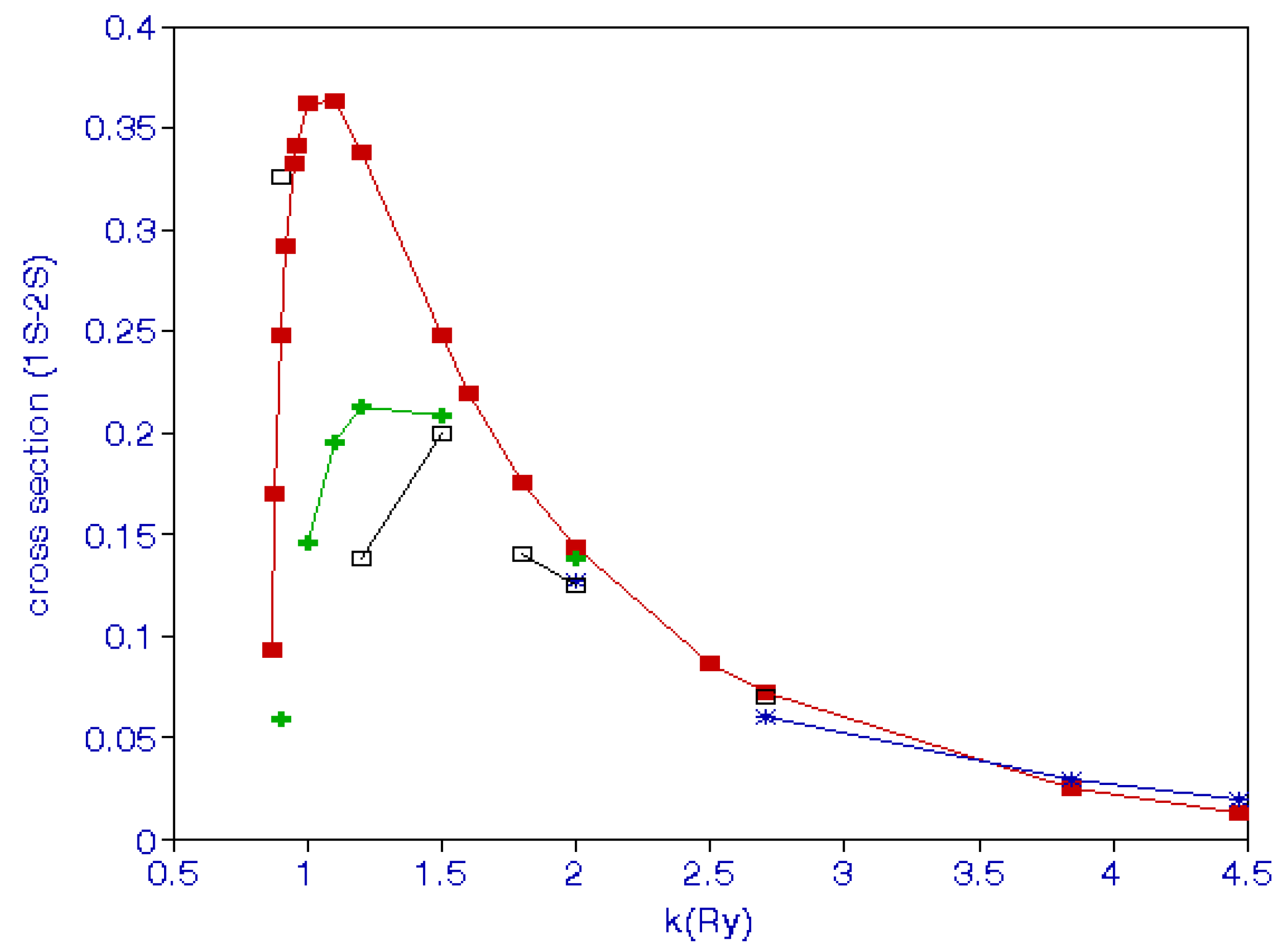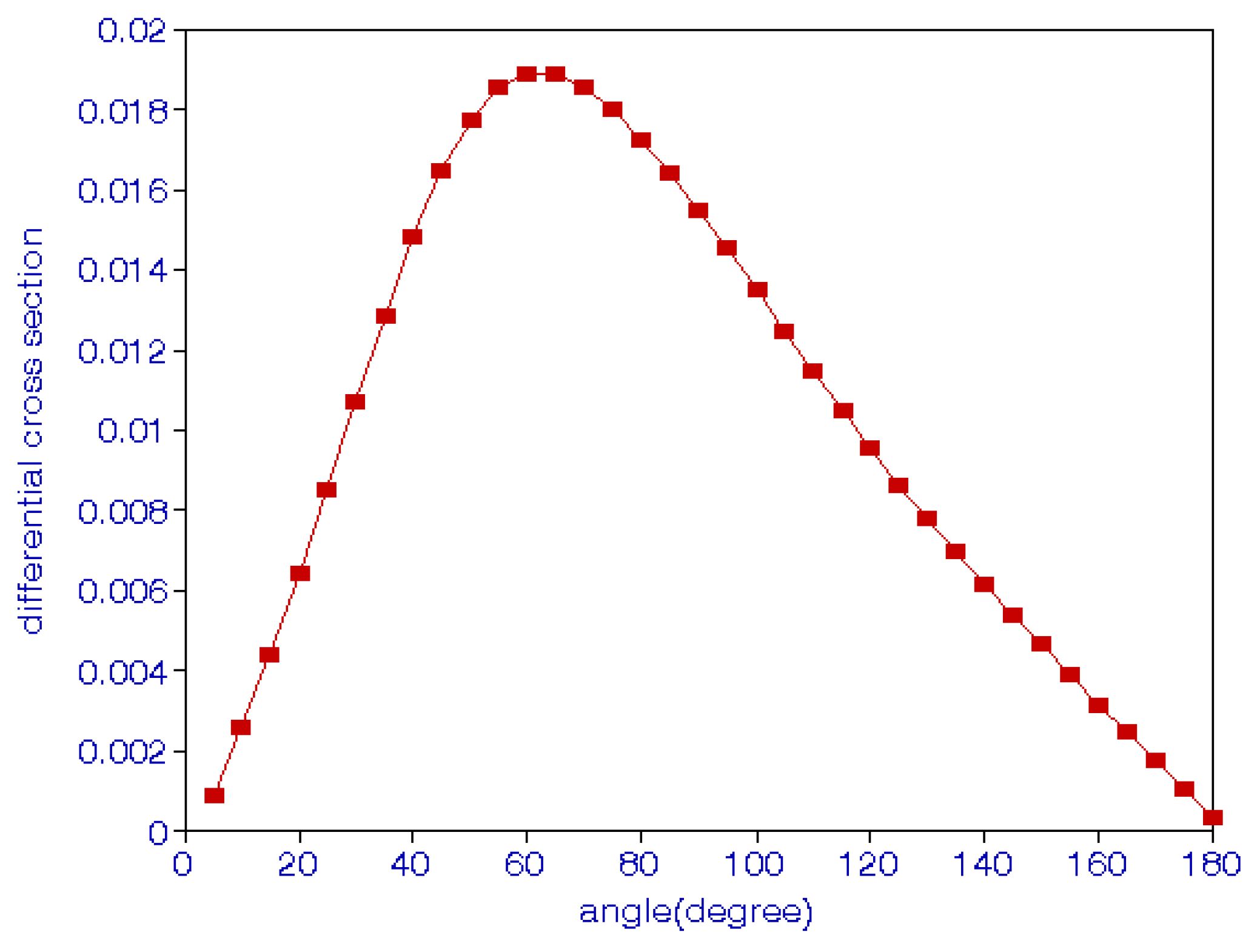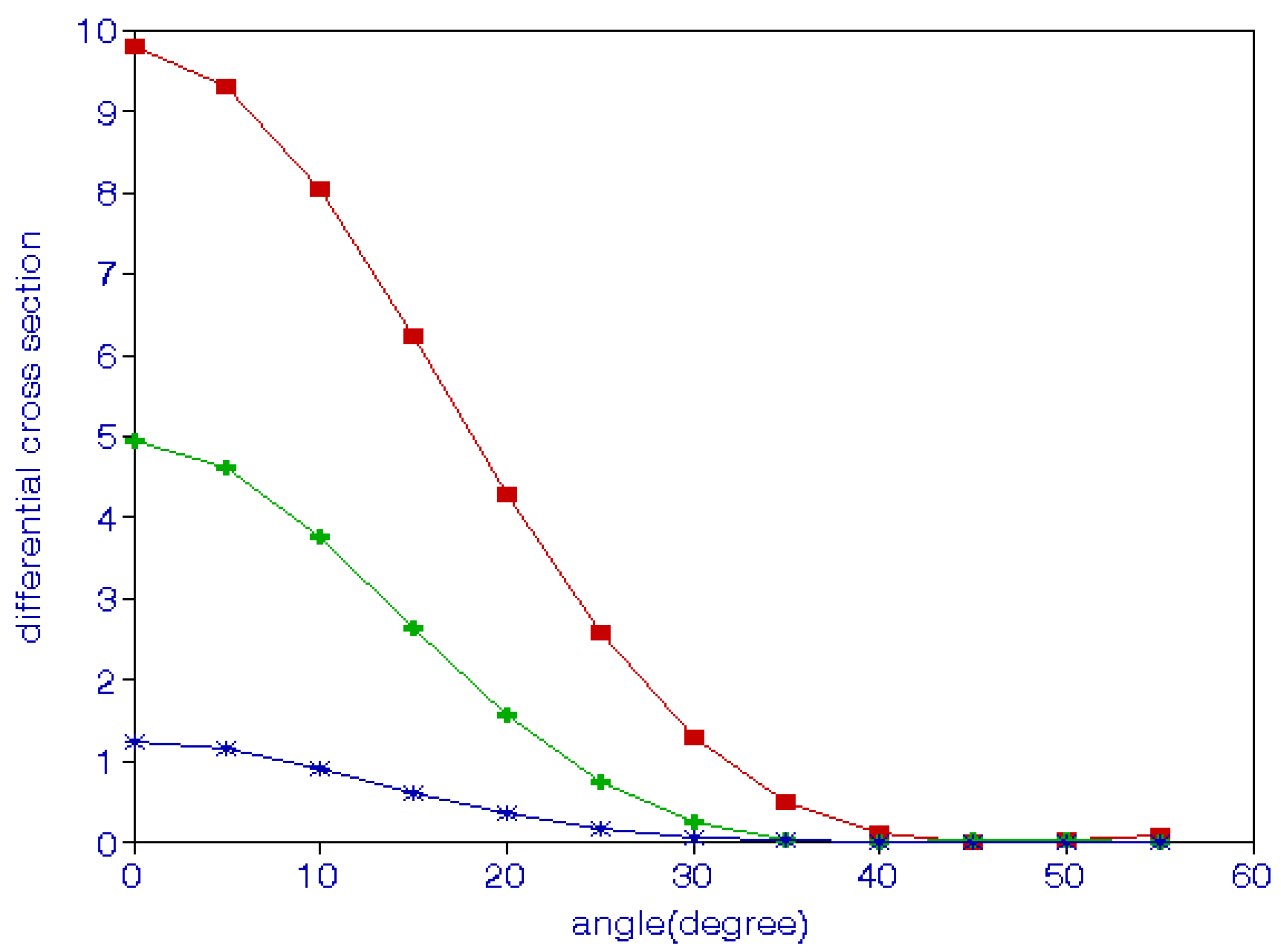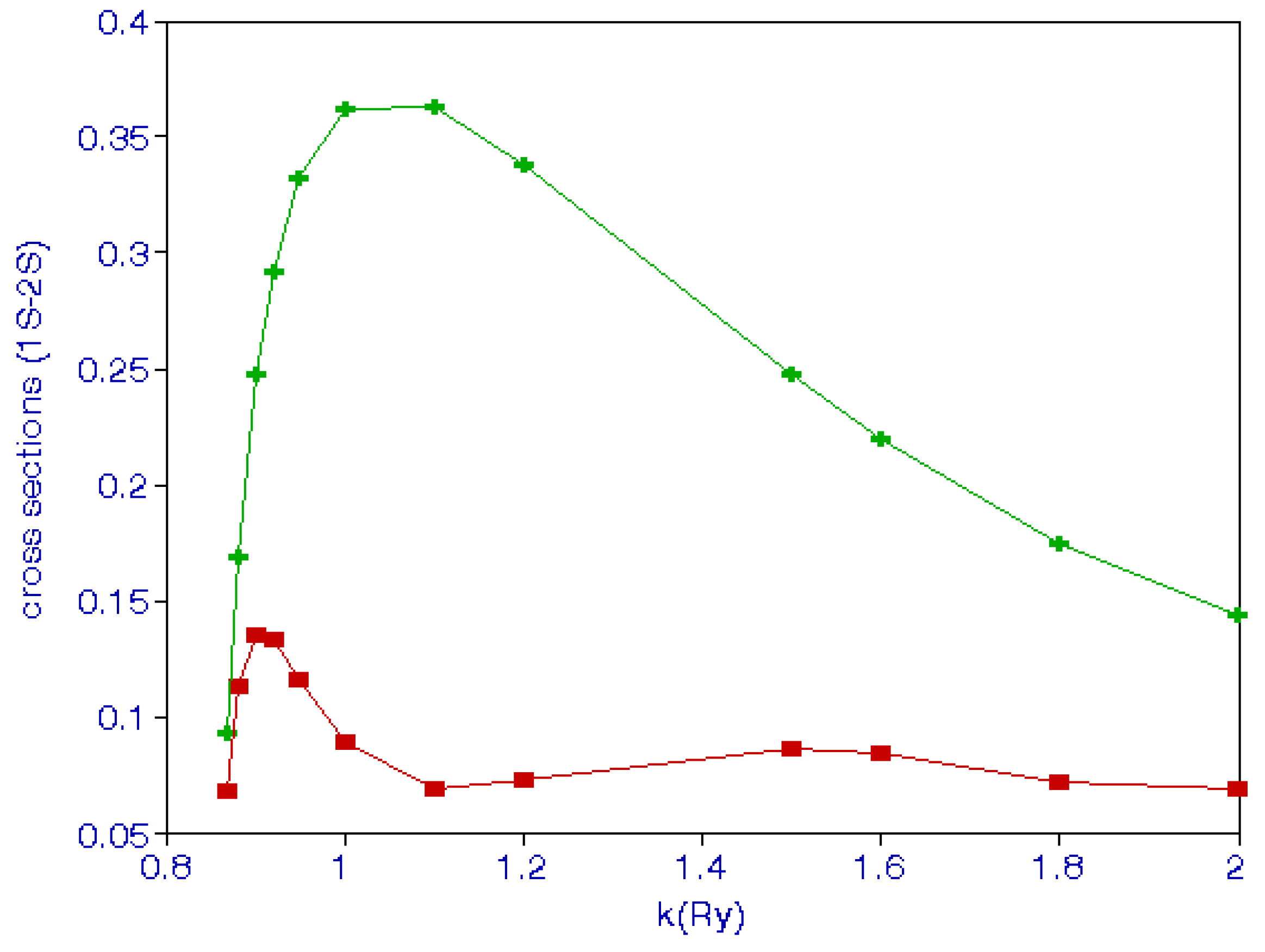Positron Impact Excitation of the 2S State of Atomic Hydrogen
Abstract
:1. Introduction
2. Theory and Calculations
3. Cross-Sections
4. Differential Cross-Sections
5. Conclusions
Funding
Acknowledgments
Conflicts of Interest
References
- Burke, P.G.; Schey, H.M.; Smith, K. Collisions of Slow Electrons and Positrons with Atomic Hydrogen. Phys. Rev. 1963, 129, 1258. [Google Scholar] [CrossRef]
- Morgan, L.A. Positron impact excitation of the n=2 levels of hydrogen. J. Phys. B At. Mol. Phys. 1982, 15, L25–L29. [Google Scholar] [CrossRef]
- Walters, H.R.J. Positron scattering by atomic hydrogen at intermediate energies: 1s-1s, 1s-2s, and 1s-2p transitions. J. Phys. B At. Mol. Opt. Phys. 1988, 21, 1893. [Google Scholar] [CrossRef]
- Kernoghan, A.A.; Robinson, D.J.R.; McAlinden, M.T.; Walters, H.R.J. Positron scattering by atomic hydrogen. J. Phys. B At. Mol. Opt. Phys. 1996, 29, 2089–2102. [Google Scholar] [CrossRef]
- Das, B.; Rej, P.; Kamali, M.Z.M.; Ghoshal, A. Positron Impact Excitation of Hydrogen Atom under Lorentzian Astrophysical Plasmas. J. Fiz. Malays. 2018, 39, 30001–30009. [Google Scholar]
- Ghosh, A.S.; Sarkar, N.K. Positron-hydrogen scattering at low and medium energies using CCA. J. Phys. B At. Mol. Opt. Phys. 1994, 27, 759–779. [Google Scholar]
- Mitroy, J.; Ratnavelu, K. The positron-hydrogen system at low energies. J. Phys. B At. Mol. Opt. Phys. 1995, 28, 287–306. [Google Scholar] [CrossRef]
- Ratnavelu, K.; Brunger, M.J.; Buckman, S.J. Recommended Positron Scattering Cross Sections for Atomic Systems. J. Phys. Chem. Ref. Data 2019, 48, 023102. [Google Scholar] [CrossRef] [Green Version]
- Merzbacher, E. Quantum Mechanics; John Wiley and Sons: New York, NY, USA; London, UK, 1998; p. 381. [Google Scholar]
- Bhatia, A.K. P-Wave Positron-Hydrogen Scattering, Annihilation, and Positronium Formation. Atoms 2017, 5, 17. [Google Scholar] [CrossRef]
- Bhatia, A.K. Hybrid theory of electron-hydrogen elastic scattering. Phys. Rev. A 2007, 75, 032713. [Google Scholar] [CrossRef]
- Bhatia, A.K. Excitation of the 2S State of Atomic Hydrogen by Electron Impact. Atoms 2018, 6, 7. [Google Scholar] [CrossRef]
- Temkin, A.; Lamkin, J.C. Application of the Method of Polarized Orbitals to the Scattering of Electrons from Hydrogen. Phys. Rev. 1961, 121, 788. [Google Scholar] [CrossRef]
- Shertzer, J.; Temkin, A. Direct calculation of the scattering amplitude without partial-wave analysis. III. Inclusion of correlation effects. Phys. Rev. A 2006, 74, 052701. [Google Scholar] [CrossRef]
- Bhatia, A.K. Hybrid theory of P -wave electron-hydrogen elastic scattering. Phys. Rev. A 2012, 85, 052708. [Google Scholar] [CrossRef]
- Saxena, S.; Gupta, G.P.; Mathur, K.C. Excitation of the hydrogen atom from its ground and metastable states by positron and proton impact at intermediate energies. J. Phys. B At. Mol. Phys. 1984, 17, 3743. [Google Scholar] [CrossRef]
- Cheshire, I.M.; Sullivan, E.C. Excitation of Atomic Hydrogen by Proton; NASA/Goddard Space Flight Center Publication: Greenbelt Rd, MD, USA, 1965. [Google Scholar]
- Kołakowska, A.; Pindzola, M.S.; Robicheaux, F.; Schultz, D.R.; Wells, J.C. Excitation and charge transfer in proton-hydrogen collisions. Phys. Rev. A 1998, 58, 2872–2880. [Google Scholar] [CrossRef] [Green Version]
- Sabbah, A.S.; Tantawi, R.S. Excitation of hydrogen atom by proton and antiproton. Il Nuovo Cimento D 1996, 18, 59–68. [Google Scholar] [CrossRef]
- Bhatia, A.K. Applications of P-wave hybrid theory to the scattering of electrons from He+ and resonances in He and H−. Phys. Rev. A 2012, 86, 032709. [Google Scholar] [CrossRef]
- Bhatia, A.K. Hybrid theory of P-wave electronLi2+ elastic scattering and photoabsorption in two-electron systems. Phys. Rev. A 2013, 87, 042705. [Google Scholar] [CrossRef]




| K | Present | Ref. [1] | Ref. [2] | Ref. [3] | Ref. [4] | Ref. [5] | Ref. [6] |
|---|---|---|---|---|---|---|---|
| 0.87 | 9.35(−2) | ||||||
| 0.88 | 1.70(−1) | ||||||
| 0.90 | 2.47(−1) | 5.9(−2) | 3.25(−2) | ||||
| 0.92 | 2.92(−1) | ||||||
| 0.95 | 3.32(−1) | ||||||
| 0.96 | 3.41(−1) | ||||||
| 1.00 | 3.61(−1) | 1.46(−1) | |||||
| 1.10 | 3.63(−1) | 1.95(−1) | |||||
| 1.20 | 3.38(−1) | 2.13(−1) | 1.38(−1) | ||||
| 1.50 | 2.48(−1) | 2.08(−1) | 2.61(−1) | ||||
| 1.60 | 2.20(−1) | ||||||
| 1.80 | 1.75(−1) | 1.40(−1) | |||||
| 2.00 | 1.44(−1) | 1.38(−1) | 1.27(−1) | 1.25(−1) | 9.90(−2) | ||
| 2.50 | 8.66(−2) | ||||||
| 2.711 | 7.21(−2) | 6.10(−2) | 7.00(−2) | 5.70(−2) | 5.80(−2) | ||
| 3.843 | 2.60(−2) | 3.00(−2) | 3.00(−2) | 2.90(−2) | |||
| 4.4696 | 1.28(−2) | 2.00(−2) | 1.80(−2) |
| k | Lmax = 0 | Lmax = 1 | Lmax = 2 | Lmax = 3 | Lmax = 4 | Lmax = 5 | Lmax = 6 | Lmax = 7 | Lmax = 8 |
|---|---|---|---|---|---|---|---|---|---|
| 0.87 | 9.3473(−2) | 9.3542(−2) | 9.3542(−2) | ||||||
| 0.88 | 1.6913(−1) | 1.6958(−1) | 1.6958(−1) | 1.6958(−1) | |||||
| 0.90 | 2.4580(−1) | 2.4574(−1) | 2.4746(−1) | 2.4747(−1) | |||||
| 0.92 | 2.8914(−1) | 2.2924(−1) | 2.9244(−1) | 2.9248(−1) | 2.9248(−1) | ||||
| 0.95 | 3.2599(−1) | 3.3201(−1) | 3.3204(−1) | 3.3215(−1) | 3.3217(−1) | 3.3218(−1) | 3.3218(−1) | ||
| 0.96 | 3.3363(−1) | 3.4068(−1) | 3.4072(−1) | 3.4085(−1) | 3.4089(−1) | 3.4090(−1) | 3.4090(−1) | ||
| 1.0 | 3.5002(−1) | 3.6108(−1) | 3.6109(−1) | 3.6138(−1) | 3.6150(−1) | 3.6152(−1) | 3.6153(−1) | ||
| 1.1 | 3.4147(−1) | 3..6159(−1) | 3.6168(−1) | 3.6228(−1) | 3.6278(−1) | 3.6298(−1) | 3.6304(−1) | ||
| 1.2 | 3.0884(−1) | 3.3530(−1) | 3.3602(−1) | 3.3657(−1) | 3.3747(−1) | 3.3800(−1) | 3.3819(−1) | 3.3819(−1) | |
| 1.5 | 2.0753(−1) | 2.4031(−1) | 2.4000(−1) | 2.4520(−1) | 2.4571(−1) | 2.4589(−1) | 2.4684(−1) | 2.4743(−1) | 2.4776(−1) |
| 1.6 | 1.8106(−1) | 2.1083(−1) | 2.1166(−1) | 2.1680(−1) | 2.1720(−1) | 2.1832(−1) | 2.1963(−1) | 2.1964(−1) | 2.1964(−1) |
| 1.8 | 1.3909(−1) | 1.6455(−1) | 1.7210(−1) | 1.7306(−1) | 1.7309(−1) | 1.7369(−1) | 1.7497(−1) | 1.7502(−1) | 1.7508(−1) |
| 2.0 | 1.0830(−1) | 1.2985(−1) | 1.3853(−1) | 1.4033(−1) | 1.4048(−1) | 1.40−64(1) | 1.4135(−1) | 1.4222(−1) | 1.4302(−1) |
| 2.5 | 6.1313(−2) | 7.4516(−2) | 8.0809(−2) | 8.3483(−2) | 8.6560(−2) | 8.6596(−2) | 8.6596(−2) | 8.6596(−2) | 8.6597(−2) |
| 2.711 | 4.9474(−2) | 6.0347(−2) | 6.6592(−2) | 6.8987(−2) | 7.2110(−2) | 7.2117(−2) | 7.2119(−2) | 7.2119(−2) | 7.2119(−2) |
| 3.834 | 1.8448(−2) | 2.2409(−2) | 2.4813(−2) | 2.54458(−2) | 2.5950(−2) | 2.5957(−2) | 2.5957(−2) | 2.5958(−2) | 2.5958(−2) |
| 4.696 | 1.0044(−2) | 1.2118(−2) | 1.2505(−2) | 1.2683(−2) | 1.2809(−2) | 1.2819(−2) | 1.2821(−2) | 1.2822(−2) | 1.2822(−2) |
| k | Born Approx. | Hybrid Theory |
|---|---|---|
| 0.87 | 7.33(−2) | 9.35(−3) |
| 0.90 | 1.86(−1) | 2.48(−2) |
| 0.93 | 2.27(−1) | 2.27(−1) |
| 0.96 | 2.37(−1) | 3.40(−1) |
| 1.0 | 2.41(−1) | 3.61(−1) |
| 1.5 | 1.27(−1) | 2.48(−1) |
| 2.0 | 7.14(−2) | 1.43(−1) |
| 2.5 | 4.57(−2) | 8.65(−2) |
| 2.711 | 3.89(−2) | 7.21(−2) |
| 3.834 | 1.96(−2) | 2.60(−2) |
| 4.696 | 1.31(−2) | 1.28(−2) |
| k | 1.0 | 2.5 | 3.834 | 4.696 |
|---|---|---|---|---|
| 0 | 1.99(−2) | 9.78 | 4.93 | 1.24 |
| 5 | 2.75(−2) | 9.31 | 4.61 | 1.15 |
| 10 | 5.59(−2) | 8.02 | 3.76 | 9.10(−1) |
| 15 | 1.17(−1) | 6.21 | 2.64 | 6.13−1) |
| 20 | 2.20(−1) | 4.28 | 1.55 | 3.49(−1) |
| 25 | 3.57(−1) | 2.57 | 7.21(−1) | 1.67(−1) |
| 30 | 5.08(−1) | 1.29 | 2.33(−1) | 6.83(−2) |
| 35 | 6.40(−1) | 4.95(−1) | 3.33(−2) | 2.53(−2) |
| 40 | 7.27(−1) | 1.10(−1) | 7.22(−4) | 1.03(−2) |
| 45 | 7.52(−1) | 1.55(−3) | 1.92(−2) | 5.91(−3) |
| 50 | 7.18(−1) | 2.60(−2) | 2.60(−2) | 5.04(−3) |
| 55 | 6.42(−1) | 7.20(−2) | 1.35(−2) | 4.87(−3) |
| 60 | 5.44(−1) | 8.29(−2) | 9.91(−4) | 4.21(−3) |
| 65 | 4.44(−1) | 5.48(−2) | 3.95(−3) | 2.94(−3) |
| 70 | 3.55(−1) | 1.66(−2) | 1.969(−2) | 1.68(−3) |
| 75 | 2.82(−1) | 2.15(−6) | 3.33(−2) | 9.08(−4) |
| 80 | 2.24(−1) | 1.63(−2) | 3.25(−2) | 6.76(−4) |
| 85 | 1.79(−1) | 5.04(−2) | 1.84(−2) | 8.76(−4) |
| 90 | 1.44(−1) | 7.53(−2) | 3.52(−3) | 1.49(−3) |
| 95 | 1.15(−1) | 7.33(−2) | 9.89(−4) | 2.33(−3) |
| 100 | 9.07(−2) | 4.78(−2) | 1.36(−2) | 2.88(−3) |
| 105 | 7.02(−2) | 1.74(−2) | 3.16(−2) | 2.61(−3) |
| 110 | 5.35(−2) | 8.60(−4) | 4.02(−2) | 1.57(−3) |
| 115 | 4.07(−2) | 4.84(−3) | 3.20(−2) | 4.35(−4) |
| 120 | 3.16(−2) | 2.24(−2) | 1.32(−2) | 3.88(−4) |
| 125 | 2.57(−2) | 4.03(−2) | 4.48(−4) | 6.10(−4) |
| 130 | 2.22(−2) | 4.78(−2) | 7.07(−3) | 1.89(−3) |
| 135 | 2.04(−2) | 4.10(−2) | 3.19(−2) | 3.07(−3) |
| 140 | 1.95(−2) | 2.36(−2) | 5.78(−2) | 3.42(−3) |
| 145 | 1.86(−2) | 5.43(−3) | 6.45(−2) | 2.69(−3) |
| 150 | 1.74(−2) | 1.14(−3) | 4.48(−2) | 1.30(−3) |
| 155 | 1.54(−2) | 2.64(−2) | 1.40(−2) | 1.52(−4) |
| 160 | 1.30(−2) | 9.12(−2) | 1.14(−4) | 2.63(−4) |
| 165 | 1.05(−2) | 1.92(−1) | 2.32(−2) | 2.08(−3) |
| 170 | 8.39(−3) | 3.06(−1) | 7.83(−2) | 5.09(−3) |
| 175 | 7.05(−3) | 3.97(−1) | 1.35(−1) | 7.91(−3) |
| 180 | 6.59(−3) | 4.32(−1) | 1.60(−1) | 9.06(−3) |
| E (keV) | Proton | Antiproton |
|---|---|---|
| 6 | 0.5 | 0.8 |
| 10 | 2.5 | 4.0 |
| 20 | 5.0 | 3.0 |
| 60 | 2.0 | 0.8 |
| 100 | 0.8 | 0.5 |
© 2019 by the author. Licensee MDPI, Basel, Switzerland. This article is an open access article distributed under the terms and conditions of the Creative Commons Attribution (CC BY) license (http://creativecommons.org/licenses/by/4.0/).
Share and Cite
Bhatia, A.K. Positron Impact Excitation of the 2S State of Atomic Hydrogen. Atoms 2019, 7, 69. https://doi.org/10.3390/atoms7030069
Bhatia AK. Positron Impact Excitation of the 2S State of Atomic Hydrogen. Atoms. 2019; 7(3):69. https://doi.org/10.3390/atoms7030069
Chicago/Turabian StyleBhatia, A.K. 2019. "Positron Impact Excitation of the 2S State of Atomic Hydrogen" Atoms 7, no. 3: 69. https://doi.org/10.3390/atoms7030069
APA StyleBhatia, A. K. (2019). Positron Impact Excitation of the 2S State of Atomic Hydrogen. Atoms, 7(3), 69. https://doi.org/10.3390/atoms7030069




